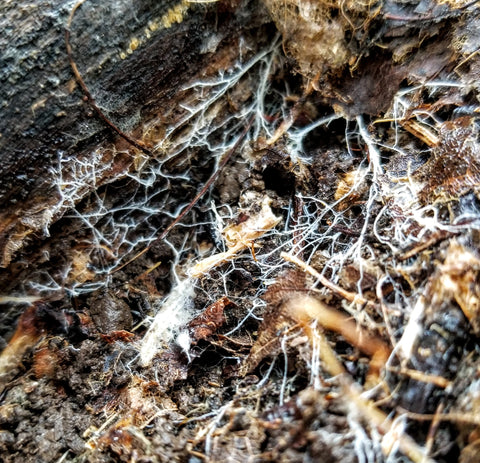
New Jewelry Material: Mycelium, Growing Green Adornment

For the past 11 months, my studio life and creative time have become consumed by mycelium. Mycelium is the vegetative stage of what we know as mushrooms, it’s the white fibrous stuff you see under a rotting log in the woods or under wood chips around your home.

A year ago I read a book that mentioned ‘the largest living organism on earth’ which is a patch of honey mushroom mycelium (Armillaria) growing in a forest in Oregon. This fascinated me, so I followed my curiosity. I began to read articles and watch videos and learn about all aspects of mycelium. This grew into hunting and photographing mycelium around my home as well as drawing and sculpting mycelium forms in clay.

I discovered the work of artists like Phillip Ross who was fabricating art installations out of grown mycelium blocks. This led me to wonder if you can build with mycelium, could jewelry be made from it?!
Phil Ross, mycelium brick arch, c. 2013
Again I followed my curiosity and learned, most of the steps required to grow mycelium are identical to those followed by mushroom growers. I discovered there is a world of amateur mycologists and mushroom growers who are very open to sharing their processes. Inspired by this knowledge and community, I built a mycology lab in my art studio and for the past 8 months, have been learning the steps and skills required to grow mycelium in a controlled way.


With many failures under my belt, I am now having some success with ‘growing’ mycelium necklace pendant forms here in the studio.
.Mycelium is a true ‘green’ material, not a little green like the recycled silver I have been using for years but actually living, organic, sustainable material that can be grown on organic waste.


As an art material, mycelium has an unusual combination of properties. First, unlike all other jewelry materials I have worked with, the primary method of forming mycelium is by growing! You can mostly control the shape and form of mycelial growth by arranging the loose material it grows in, called substrate, in specific ways such as plastic molds. Mycelium colonizes the damp hardwood sawdust substrate by growing it’s fibrous web-like branches into and between the wood fibers in the plastic mold. The entire growing phase can take many weeks, even months.
 .
. 
Once you have heated and dried the finished form, the mycelium is killed and ready to be worked at the jewelry bench. The working properties of the dried mycelium are not like anything I have worked with before. It is remarkably lightweight and feels a bit like styrofoam. This makes it a wonderful material to make pendant necklace forms as you can make a large statement piece without the unfriendly weight associated with other materials. You can work the dried mycelium similarly to wood, drill, saw, sand and glue, etc. Next, you can actually grow materials into the substrate such as beads, wire, wooden parts, fabrics and found objects allowing the mycelium to literally grow into and around design elements anchoring them in place.
 .
. 
When I began the process of working with mycelium, my experiments were entirely about learning the methods required to grow and work with the material. I am now entering the phase where process is taking a backseat to artistic design. What can you creatively do with this new art material? I am just beginning to experiment with the possibilities of incorporating precious metals, stones, color, and texture with mycelium.

A year ago, I had never heard of mycelium and now I find myself as a jewelry pioneer with this amazing material. I am dedicated to sharing the things I have learned about how to effectively design with this new art material. In the near future, I see myself reaching out to collaborate with other jewelry artists to test the creative and structural limits of the medium. I encourage you to follow my journey on social media Instagram: @silverbeehivestudio


Lynn Lin
Hi Steve, how are you? I ran across your mycelium jewelry collection and was very intrigued by your process. I’m teaching the material class at Parsons and have my friend over for a demo. Do you know if mycelium can grow into an air-dried clay mold directly without the step of vacuum forming? Basically I would ask students to make a bowl shape with clay and stuff mycelium in there to grow into the shape. If it will grow into clay would it eventually take the form of the shape from the outside as well? If that can happen it will save a lot of time in between. Hope to get your expertise on this! Very much appreciated!
Jane
Hi Steven
I finally got to your web site and learned a ton about mycelium. It is all wonderful and fascinating. Ruth keeps me updated
Love to you and Christy
Jane
Karen
OMG: This is fascinating. You are amazing. I love your mind!